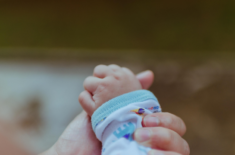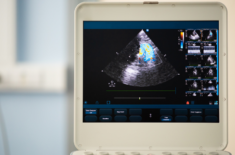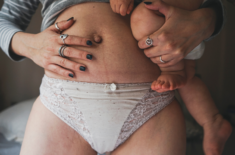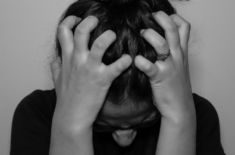How Long Can Postpartum Depression Affect You?
Motherhood is beautiful, yet it’s estimated that as many as 21.9% of women experience PPD (postpartum depression) within the first year after childbirth. (1)
What’s sad, however, is that only around 14% of moms with PPD seek treatment, and as many as 25% still show symptoms even up to three years after giving birth. (1)(2)
Because PPD can last longer than expected, researchers recommend maternal depression screening even beyond the postpartum period (up to two years after birth). (2)
Can PPD go away without medication? What other mood disorders can affect moms after giving birth? How long does postpartum psychosis last, and what are its early warning signs?
If you believe that you have PPD or recently been diagnosed with this mood disorder, we’re here for you, mama. Learn more about PPD below.
What’s Postpartum Depression?
PPD is a medical condition commonly experienced by new moms after delivery.
It can affect your quality of life, but it isn’t a character flaw or a sign that you’re weak, mama.
Here are some of these most common symptoms of postpartum depression: (3)
- Regular mood swings
- Strong feelings of sadness or worthlessness
- Trouble sleeping
- Loss of interest in usual activities
- Anxiety (worry) after giving birth
- Suicidal thoughts or attempts
Postpartum Depression Timeline
There isn’t a standard PPD timeline. Some moms only experience it briefly, but others take longer, especially without treatment.
PPD duration can depend on certain factors:
- The sooner treatment starts with your mental health care provider, the faster it can improve your symptoms.
- You also have an increased risk if you have a personal or family history of PPD, other forms of mood disorders, or mental health concerns.
For most moms, treatment can shorten the duration of PPD. The good news is that some treatment options are considered safe for use while breastfeeding. Be sure to discuss these baby-safe treatments with your doctor.
When Does Postpartum Depression Typically Start?
Early Onset (Perinatal Depression)
Recent studies show that perinatal depression (experienced from pregnancy to postpartum) rates may have tripled during the coronavirus pandemic. (4)
So, your symptoms might already be there even during pregnancy. However, these can be harder to miss because people usually associate anxiety and depression with the period after birth.
You might even hear people say that you’re “just having baby blues.” But even if 15–85% of moms can experience “baby blues” within the first 10 days after giving birth, it’s different from PPD. (3)(5)
Baby blues are sad feelings you possibly get due to physical fatigue and sleep deprivation from having a new baby. But PPD is a more severe condition caused by an imbalance in your brain chemistry, hormone fluctuations, or other factors. (6)(7)
With PPD, the symptoms can be more intense and last longer than two weeks. Baby blues typically go away on their own after just a few days.
Typical Onset
The symptoms of postpartum depression typically begin showing within a few days or around four weeks after you give birth.
These symptoms can vary because there are many different reasons why moms experience PPD.
Studies show that hormonal changes (particularly estrogen and progesterone levels) can play a big role. (7)
After giving birth, hormone levels can quickly return to normal. Studies show that estrogen levels can drop as much as 100x within 48 hours after you give birth, causing PPD symptoms to appear. (7)
That’s why an estrogen patch can resolve these sudden hormone fluctuations and help reduce PPD symptoms for new mothers. (7)
Also, giving birth can be a physically demanding and stressful experience. During stressful events, a chemical imbalance in the brain can lower serotonin levels. Serotonin is known as our body’s “feel-good hormones.” (8)
Low serotonin levels can make you feel sad. If this continues for weeks, then it can lead to postpartum depression. (8)
Late Onset
There are times when PPD can develop late, from around 5-12 weeks postpartum. Sometimes, late-onset PPD can even start about one year or longer after giving birth. (9)(10)
Because postpartum depression can start late or last longer, the NIH (National Institutes of Health) recommends longer screening periods after birth to help diagnose and treat more moms. (11)
How Long Does It Take To Mentally Recover From Having A Baby?
PPD: Within One Year After Giving Birth
A 2014 literature review of several studies published in the Harvard Review of Psychiatry shows that a lot of moms continue to show PPD symptoms several months after giving birth: (12)
- 27-48% at 3-4 months postpartum (four studies)
- 30-62% at six months (six studies)
- 25-31% at nine months (two studies)
PPD: One Year Or Longer After Giving Birth
Research published in Pediatrics (2020) shows that as many as 25% of moms still show signs of PPD up to three years after giving birth. (2)
So, the researchers recommend maternal depression screening even beyond the postpartum period (up to two years after birth), especially for moms with a history of mood and diabetic disorders. (2)
The 2014 Harvard Review of Psychiatry study mentioned above had these findings for PPD one year after giving birth or longer: (12)
- 6-39% at 12 months (four studies)
- 18% at 18 months (one study)
- 13-46% at two years (four studies)
- 17-62% at three years (two studies)
These findings suggest that at any given time between four months and three years postpartum, as many as 30% of moms might meet the criteria for depression.
Is Postpartum Depression A Chronic Disease?
No. Cases of depression are only considered as PPD if they happen within the postpartum period. However, it can progress to MDD (major depressive disorder) if left untreated. (1)
Studies show that 50% of moms diagnosed with MDD developed the episode after delivery, while 25% developed the episode during pregnancy. (1)
How Long Are You Considered Postpartum?
The postpartum period starts on the day you give birth, although the end of this period isn’t clearly defined. Usually, it’s up to six weeks after birth. However, delayed postpartum can also start after the six-week mark and last for six months or more.
Although as mentioned earlier, some moms still exhibit signs of postpartum depression at three years after delivery. (12)
Risk Factors For Long-Term PPD
The timeline for postpartum depression is different for everyone, even those who receive treatment.
Here are some of the risk factors that can make PPD last longer for you: (11)
- History of depression, anxiety, mental illness, bipolar disorder, or other mental health conditions
- History of PPD in a previous pregnancy
- Early-onset, such as perinatal depression that starts during pregnancy
- Medical complications during pregnancy and delivery
- Difficult breastfeeding
- Severe symptoms
- Waiting several weeks before you started treatment
- Continued exposure to your stressors
- Stressful life events (example, the recent death of a family member or loved one)
- Major life changes (such as losing a job or moving to a new place)
- Poor relationship or lack of support from your partner and family
- History of sexual or domestic abuse
- Experience with gestational diabetes (higher-than-normal blood sugar levels during pregnancy)
- Younger (or teen) moms
- Less education
- Use of alcohol or recreational drugs (such as weed)
- Premature birth or early deliver
- Giving birth to a baby with health conditions or complications
Still, there’s no formula to determine whether you’ll have PPD and for how long it’ll last. Even women without risk factors can still develop PPD.
With the right treatment or intervention, especially when it’s received early, you can find relief from your PPD symptoms even if you have any of these risk factors.
But you don’t have to worry if you have these risk factors, too. Having a higher risk doesn’t automatically mean you’ll actually experience long-term PPD.
What’s more important is getting early treatment if you experience symptoms of PPD.
Postpartum Depression Treatment
PPD treatment depends on your situation and the severity of your symptoms. Sometimes, you might need to make lifestyle changes, and your doctor might prescribe more than one treatment strategy.
Your treatment options can include:
- Getting proper nutrition (which can help increase your brain’s serotonin levels or “feel-good hormones”) (8)
- Practicing breathwork
- CBT (cognitive-behavioral therapy) to manage negative thoughts
- IPT (interpersonal psychotherapy) to identify and manage personal and interpersonal problems
- Antidepressants (such as SSRIs or selective serotonin reuptake inhibitors)
- Group therapy
- Finding a support group
Delayed Postpartum Depression: Symptoms & Treatment
Delayed or late-onset PPD has the same symptoms as regular PPD. The only difference is that it starts later (anytime from five weeks to 18 months after you give birth). (9)(10)
Can PPD Go Away Without Medication?
The answer depends on your situation. Researchers acknowledge that PPD is complex. It’s not easy to assess if recovery was due to treatment or other factors. Sometimes, moms can recover without intervention. (12)
What’s clear, however, is that treatment can speed up the healing process.
Studies show that moms who receive supportive counseling are less likely to still have depression at one-year follow-up than those who didn’t receive any intervention or treatment. (12)
Around 69% of moms fully recovered after three months of counseling for postnatal depression, compared with 38% of the control group (moms who didn’t receive the treatment). (13)
What’s sad, however, is that only around 14% of women with PPD seek treatment. (1)
How Long-Term PPD Can Affect Your Life
PPD can affect women’s health, their partners, and their babies.
But remember, mama, that it isn’t your fault. That’s why it’s important to seek treatment and shorten your depression timeline before the situation worsens.
Effect On Moms
Research suggests that PPD can decrease a new mother’s physical and mental health score. It can lead to “risky behaviors,” including smoking, drinking alcohol, and suicidal thoughts or attempts. (14)(15)
PPD also appears to affect mother-baby interactions, such as breastfeeding, maternal bonding, and the feeling of satisfaction in your maternal role. (14)
The longer you have PPD, the higher your risk of developing major depression or chronic depressive disorder. (16)
Effect On Relationships
Moms with PPD may experience more distant or difficult relationships with their partners and other family members. Studies show that more depressed moms are involved in relationship breakups than non-depressed moms. (14)
Some studies also show that women with PPD are nearly three times more likely to have sexual dysfunction in the first year after childbirth. (14)(17)
Not surprisingly, 24-50% of dads whose partners have PPD are likely to experience it themselves, too. (18)
Effect On Your Baby
PPD can also affect your baby, leading to poor social-emotional, language, motor, adaptive behavior, and cognitive development, which can even extend to adolescence. (19)
It can also cause problematic infant sleep patterns, more night-time awakenings, less weight gain, and increased physical health concerns. (20)
When Is PPD An Emergency?
PPD becomes a serious case if you consider suicide or harming your baby.
If you’re having these thoughts or know someone who could hurt themselves or their baby, you can do the following:
- Call the National Suicide Prevention Lifeline; the hotline (800-273-8255) is available 24 hours a day.
- Text HOME or HELLO to the Crisis Textline (741741); it’s also available 24/7
- Call 911 or your local emergency number
- Talk to or visit a healthcare professional.
- Visit an emergency room.
- Find a helpline in your current country if you’re not in the US.
Serious cases of PPD are rare, but they can still happen. The most serious cases are often attributed to postpartum psychosis, a mental illness possibly affecting 1-2 new moms out of 1,000 childbirths. (21)(22)
How Long Does Postpartum Psychosis Last?
The most severe symptoms might last 2-12 weeks, but it can take 6-12 months or even more for someone with postpartum psychosis to make a full recovery. (23)
But with treatment and the right support, you can overcome this situation, mama. You’re not alone.
Here’s a comprehensive article on postpartum psychosis for more information on the subject.
Treatments options include: (23)
- Antidepressants – to help manage serious depression symptoms; they may be used alongside a mood stabilizer.
- Antipsychotics – to manage manic and psychotic symptoms, including hallucinations or delusions.
- Mood stabilizers – to manage your mood and prevent recurring symptoms.
- Talk therapy – such as CBT (cognitive behavioral therapy) mentioned above.
- ECT (electroconvulsive therapy) – using controlled electric currents to change the brain’s chemical composition. (16)
REFERENCES
(1) https://jamanetwork.com/journals/jamapsychiatry/fullarticle/1666651
(2) Diane L. Putnick, Rajeshwari Sundaram, Erin M. Bell, Akhgar Ghassabian, Risë B. Goldstein, Sonia L. Robinson, Yassaman Vafai, Stephen E. Gilman, Edwina Yeung; Trajectories of Maternal Postpartum Depressive Symptoms. Pediatrics November 2020; 146 (5): e20200857. 10.1542/peds.2020-0857 https://publications.aap.org/pediatrics/article/146/5/e20200857/75352/Trajectories-of-Maternal-Postpartum-Depressive
(3) https://americanpregnancy.org/healthy-pregnancy/first-year-of-life/baby-blues/
(4) https://pubmed.ncbi.nlm.nih.gov/34816146/
(5) https://www.ncbi.nlm.nih.gov/pmc/articles/PMC3918890/
(6) https://www.mentalhelp.net/blogs/postpartum-depression-neurotransmitters-and-nutrition/
(7) https://www.ncbi.nlm.nih.gov/pmc/articles/PMC2782667/
(8) https://www.mentalhelp.net/blogs/postpartum-depression-neurotransmitters-and-nutrition/
(9) https://www.ncbi.nlm.nih.gov/pmc/articles/PMC6408909/
(10) https://americanpregnancy.org/healthy-pregnancy/first-year-of-life/how-to-prevent-postpartum-depression/
(11) https://www.nih.gov/news-events/nih-research-matters/postpartum-depression-may-last-years
(12) https://journals.lww.com/hrpjournal/Fulltext/2014/01000/The_Course_of_Postpartum_Depression___A_Review_of.1.aspx
(13) https://pubmed.ncbi.nlm.nih.gov/2493868/
(14) https://www.ncbi.nlm.nih.gov/pmc/articles/PMC6492376/
(15) https://pubmed.ncbi.nlm.nih.gov/16231095/
(16) https://www.nami.org/About-Mental-Illness/Mental-Health-Conditions/Depression/Major-Depressive-Disorder-with-Peripartum-Onset
(17) https://pubmed.ncbi.nlm.nih.gov/25963126/
(18) https://www.nct.org.uk/life-parent/emotions/postnatal-depression-dads-10-things-you-should-know
(19) https://jamanetwork.com/journals/jamapediatrics/fullarticle/2770120
(20) https://pubmed.ncbi.nlm.nih.gov/21559774/
(21) https://www.postpartumdepression.org/postpartum-depression/types/
(22) https://www.pregnancybirthbaby.org.au/postpartum-psychosis
(23) https://www.nhs.uk/mental-health/conditions/post-partum-psychosis/












